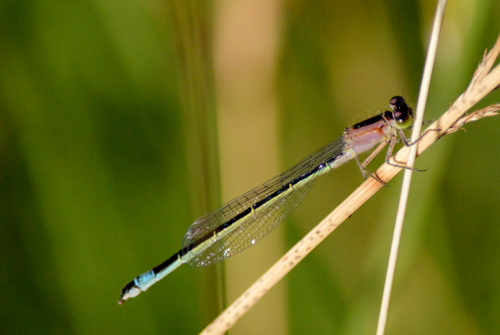Name
Ischnura elegans (Vander Linden, 1820)
Family:
Coenagrionidae
Status in Britain and Ireland:
common and widespread
Local Status:
common
Size:
Overall body length 30-34mm
Hindwing length 14-21mm
Flight period:
May until mid September
Photograph © M. Randall
Male Blue-tailed Damselfly
The body is metallic black apart from segment 8 and the underside of segment 9 which are bright blue. The thorax is blue (greenish in immatures) with a black dorsal face enclosing narrow blue antehumeral stripes. Legs are black and wings are clear with a distinctive diamond shaped bicoloured pterostigma (two toned black and white wing spot). The hind edge of the pronotum has a distinctive lobe.
Female form rufescens. Photograph © P. Hopwood
Female Blue-tailed Damselfly
All have bicoloured pterostigma and mainly black abdomens with a coloured segment 8. There are however 5 colour variations. There are 2 immature forms; rufescens and violacea. Form rufescens shown above has orange-pink sides to the thorax with a blue segment 8. This matures to form rufescens-obsoleta in which the thorax and segment 8 turn brown. Antehumeral stripes are not distinct on these 2 forms which appear to have just one mid-dorsal black stripe. Form violacea (shown in the additional photographs) has violet sides to the thorax and matures to either form typica which is like the male in colouration or form infuscans with an olive green thorax and brown segment 8.
Similar Species
The male Red-eyed Damselfly is similar due to blue colouration at the end of the abdomen but is far more robust with red eyes. Scarce Blue-tailed Damselfly is very similar though rare in Shropshire and found in very different habitat. The blue area is further down the abdomen in Scarce Blue-tailed Damselfly, occupying only part of segment 8 but all of segment 9. In addition 2 small black marks are usually present on segment 9. Scarce Blue-tailed Damselfly is smaller and has shorter pterostigma then Blue-tailed Damselfly. It also lacks the distinctive lobe on the hind edge of the pronotum. Female Scarce Blue-tailed Damselfly is distinctively orange when immature (form aurantiaca).
Behaviour
Unusually this species can be seen to emerge upside down. Immatures then remain close to the water with both males and females being found in marginal vegetation. Males are territorial and have been seen to mate with immature females. Copulation can last for several hours after which the female unusually oviposits alone. This species will continue to fly in overcast conditions and has been known to glean insects from spiders webs.
Habitat
Can be found in a variety of lowland habitats including canals, pools, ponds, ditches and slow flowing rivers and streams. Will tolerate some pollution.
Shropshire Distribution
Historic records date back to 1917 at The Albynes, Nordley (north west of Bridgnorth) followed by sightings in 1945 at Coalport and on the River Severn near Atcham. Records noticeably increased from the 1970’s onwards and Butler (1982) noted the larvae were ‘found in almost every type of aquatic habitat.’ Lockton et al., (1996) described this species as common and this is most definitely the case today. Since the latter publication the revised distribution map shows a great deal of infilling within the previously recorded range – most likely due to increased recorder effort. The far south west of the county has relatively few records though this is most likely due to a lack of recording in this area as opposed to lack of presence.
Where to see in Shropshire
Numerous canals, ponds, lakes and meres throughout the county.





